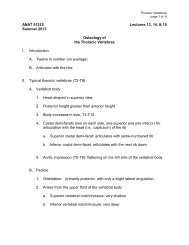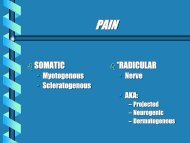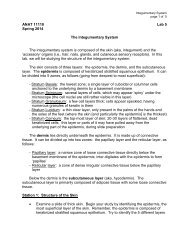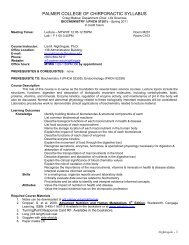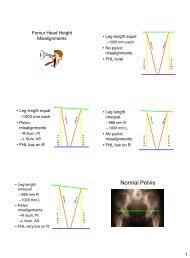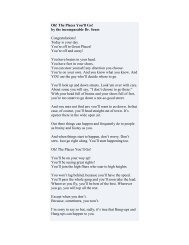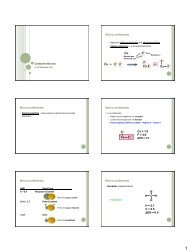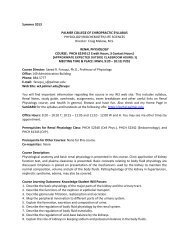Extremity-Sorgenfrey - Palmer College of Chiropractic, Intranet ...
Extremity-Sorgenfrey - Palmer College of Chiropractic, Intranet ...
Extremity-Sorgenfrey - Palmer College of Chiropractic, Intranet ...
You also want an ePaper? Increase the reach of your titles
YUMPU automatically turns print PDFs into web optimized ePapers that Google loves.
PALMER COLLEGE OF CHIROPRACTICSYLLABUSEXTREMITY ADJUSTING (TECH 81617)Summer 20135 credit hoursI. Technique Director: John Strazewski, D.C., M.S. Ed.II.III.Meeting Dates: Mondays through FridaysMeeting times and location: TECH81617 01 at 12:05 p.m. andTECH81617 02 at 1:00 p.m.; both in Room W214Course Director: Glenn <strong>Sorgenfrey</strong>, D.C., Associate Pr<strong>of</strong>essorOffice location: W217Office phone: 884-5231Office hour: 10:15 hour or by appointmentE mail: <strong>Sorgenfrey</strong>_g@palmer.eduCourse Instructors: (back-ups): TBAIV.Pre-requisite Courses: All TECH courses 1-5 triV. Co-requisite Courses: NoneVI.VII.VIII.This course is a pre-requisite to: CLIN 82831 Clinic ICLIN 82821 Clinic Case Corr ICourse description: This course places emphasis on the analytical aspects <strong>of</strong> extremity care.Consultation, examination, and X-ray techniques are covered to determine when and when not to adjustthe extremities. Analysis and adjusting <strong>of</strong> the entire appendicular skeleton are taught.Course goals: The students will be able to locate palpable landmarks in the upper and lower extremities,use a neuromuscular examination to determine joint dysfunction and devise an appropriate correctionand course <strong>of</strong> patient management.Students enrolled in this course are eligible to participate in an associated learning lab to further practicetheir examination and adjusting skills. The learning lab provides student access to faculty supervisionoutside <strong>of</strong> their assigned class hour. The lab is available on Monday from 3:45-4:35, Tuesdays from9:20-10:10 and also on Friday from 9:20-10:10. Details concerning this lab can be found atw3.palmer.edu/technique/Learning Lab.htm.1
IX. Course OutcomesA. Knowledge students will possess upon completion <strong>of</strong> the course:A1. Appreciate the need to explain what will be done when administering the chiropractic adjustment ormanipulation, discuss risks, and recognize the potential for patient apprehension and concern.A2. Value patient privacy and modesty in the course <strong>of</strong> administering chiropractic adjustments ormanipulation.A3. Be aware <strong>of</strong> the need to reassess and modify chiropractic adjustment or manipulation appropriate tothe needs <strong>of</strong> the patient.K1 Recognize clinical indicators <strong>of</strong> normal or abnormal joint function.K2 Interpret clinical findings to determine the need for chiropractic care <strong>of</strong> the upper and lowerextremitiesK3 Formulate a chiropractic listing from abnormal clinical findings.K4 Demonstrate an appropriate adjusting procedure based on clinical findings.K5 Explain how to monitor effects <strong>of</strong> extremity adjusting.K6 Formulate a management plan on a patient with extremity dysfunction.B. Skills students will possess upon completion <strong>of</strong> the course:S1 Position the patient for an extremity adjustment.S2 Palpate the extremity joints for dysfunctionS3 Demonstrates a proper chiropractic set up on a simulated patient.XI. Evaluation Methods:A. Class participation credit 4 pointsB. Shoulder practical 16 pointsC. Elbow, wrist and hand practical 20 pointsD. Upper extremity written 30 pointsE. Hip and knee practical 24 pointsF. Foot and ankle practical 24 pointsG. Final practical 28 pointsH. Final written 50 pointsTotal 196 pointsXII.Evaluation Schedule: See course calendar on Technique Dept. website,http://w3.palmer.edu/technique or the SunGARD https://portal.palmer.edu/default2
XIII.Grading Standard:184-196 points = A170-183 points = B156-169 points = C155 points or below = FXIV. Policies relating to the course:A. Academic Adjustments for Qualified Students with Disabilities Statement:<strong>Palmer</strong> <strong>College</strong> <strong>of</strong> <strong>Chiropractic</strong> makes reasonable academic adjustments for qualified students withdisabilities, as required by law. Any qualified student with a disability who requires a reasonableacademic adjustment to perform the academic and technical standards requisite to participation inthis course is to contact the Disabilities Coordinator to request such an academic adjustment.B. Statement on religious observance:In order to accommodate an individual student’s participation in religious observances, <strong>Palmer</strong><strong>College</strong> requires that the student advises each <strong>of</strong> their instructors, in writing, at the beginning <strong>of</strong> anacademic term the holiday and date <strong>of</strong> observance the student is requesting relief from theircourse(s). This policy does not in any way release the student from the responsibility <strong>of</strong> satisfyingall requirements necessary for the successful completion <strong>of</strong> any course.C. Statement on Academic Integrity:Students are expected to comply with <strong>Palmer</strong>’s Student Code <strong>of</strong> Ethics. Students are stronglyencouraged to carefully read the entire Student Code <strong>of</strong> Ethics as published in the StudentHandbook. Cheating, plagiarism, other acts <strong>of</strong> dishonesty and/or any other violation <strong>of</strong> <strong>Palmer</strong>’sStudent Code <strong>of</strong> Ethics may result in the filing <strong>of</strong> a charge <strong>of</strong> misconduct under the StudentDisciplinary Code as described in the Student Handbook. Students charged with misconduct will beassigned a grade <strong>of</strong> “Incomplete” until the charge(s) is concluded in accordance with the StudentDisciplinary Code as described in the Student Handbook. Sanctions up to and including denial <strong>of</strong>academic credit, suspension or dismissal from the <strong>College</strong> may be imposed upon students found tohave violated the Code <strong>of</strong> Student Ethics. Please refer to the <strong>Palmer</strong> Student Handbook. You mayaccess the Student Handbook online at: http://www.palmer.edu/news2.aspx?id=1688. Further,students, as a condition <strong>of</strong> admission, agree to abide by all palmer <strong>College</strong> <strong>of</strong> <strong>Chiropractic</strong>regulations contained the <strong>College</strong> Catalog, Student Handbook, other publications and notices placedon <strong>of</strong>ficial <strong>College</strong> bulletin boards, including its website.D. All other policies pertaining to Technique courses are available at the Technique Departmentwebsite, http://w3.palmer.edu/technique.XIV. Course Text(s)Required Materials: NoneSuggested materials: Extremities: Adjusting and Evaluation, BurnsXV. Other materials required by the course: Gown/towel to be placed between the skin and the adjustingequipment.XVI. Recommended reading/resources:A. Radiographic Positioning for the Chiropractor, PercuocoB. Physical Examination <strong>of</strong> the Spine and Extremities, HoppenfeldC. Joint Pain, MennelD. The Physiology <strong>of</strong> the Joint, Upper <strong>Extremity</strong>, KapandjiE. The Physiology <strong>of</strong> the Joint, Lower <strong>Extremity</strong>, KapandjiF. Radiographic Positioning and Related Anatomy, MeschanG. AMA Guide--Evaluation <strong>of</strong> Permanent ImpairmentH. What You Should Know About <strong>Extremity</strong> Adjusting, Heron3
I. Illustrated Essentials in Orthopedic Physical Assessment, EvansJ. Hammer, W., Functional S<strong>of</strong>t Tissue Examination and Treatment by Manual Methods, AspenPublicationXVIII. See the calendar link for the department website, http://w3.palmer.edu/technique, or at the SunGARDsite, https://portal.palmer.edu/default.XIX. Topic outline:Week 1 -- Introduction to extremities and shoulder ROM, O/NWeek 2 -- Shoulder examination and adjusting proceduresWeek 3 – Shoulder exam and adjusting proceduresWeek 4 – Upper extremity x-ray exam and practiceWeek 5 -- Shoulder girdle practice and practicalWeek 6 -- Elbow examination and adjusting procedures Wrist examWeek 7 – Wrist adjusting procedures, practice; hand exam and adjusting procedures;Week 8 -- Elbow, wrist and hand practical; Upper extremity written; Hip examination and adjustingprocedures, knee orthopedic examinationWeek 9 -- Knee adjusting procedures, practice;Week 10 – Hip and knee practical examination Ankle exam and adjusting proceduresWeek 11 -- Ankle and foot exam and adjusting proceduresWeek 12 -- Ankle and foot practical; practice, orthotics discussionWeek 13 – Final practical;Week 14 -- TMJ exam and adjusting procedures; Make-up examsWeek 15 -- Final writtenXX. Developed: 1990 Reviewed/Revised: February 2013* This syllabus does not constitute a contract. The purpose <strong>of</strong> the document is to provide a guide to students.The pr<strong>of</strong>essor reserves the right to alter, amend or modify the conduct <strong>of</strong> the class at his discretion.4
Dr. <strong>Sorgenfrey</strong>’s <strong>Extremity</strong> Class Rubric for Practical ExaminationsPracticals pointBreakdownsMiss 1 item = 3 pointsMiss 2 items or 1 reconsider= 2 pointsMiss 3 items or 1 reconsider& 1 item = 1 pointMiss 4 items or 2reconsiders = 0 pointsOrthopedicTestsPerformance, patientPlacement,DS, SCP,CP, positive,indicationAdjustingSet-upsDS, PP, CHCP, SCP,SH, SP,SSP, TP, RI,TQ, STAB.LOC,Question (found in theLibrary on reserve).Procedure5
Simulated Patient EvaluationGrading SheetDr. <strong>Sorgenfrey</strong> - Extremities<strong>Extremity</strong> Scenario - Card #Categories to be Graded1 Case History0 = no questions asked1 = asks question(s) regarding the scenario on the card2 = asks questions needed to make a good working diagnosis(Examiner provides answers to student’s questions)2 Differential Diagnoses:0 = none given2 = diff dx 1 subluxation from another subluxation4 = diff dx subluxation(s) from s<strong>of</strong>t tissue, visceral, or otherStudent:_____________Matric: _____________Date: __________Points Possible0 1 20 2 43 Visualization-ROM-Ortho-Neuro2 = for each area covered to rule out differential diagnoses above.VisualizationROMOrthoNeuro4 Pain PointVerbalized and pointed out location where pain point would be for the diffdx5 Fluid Motion1 = for FM for actual subluxation2 = if did FM for any differential dx0 2 4 60 20 1 26Least to Most InvasiveDid the student work using less invasive procedures before using moreinvasive procedures? 0 27Traction Adjustment:(write down move you asked student to perform)8 Thrusting Adjustment:(write down move you asked student to perform)Post Checks, Patient InstructionsFM if appropriate, pain point, ROM, neurologic tests, other.Patient instructions (if appropriate)0 1 2 3 40 1 2 3 40 1 2Total Points28 PossibleGrader’s Initials: __________Comments:6



